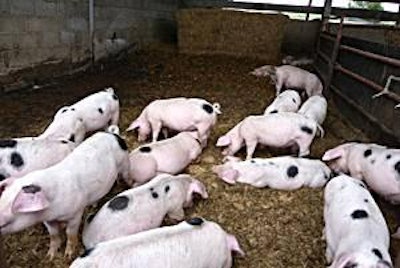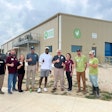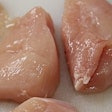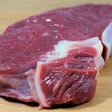
A group of dedicated UK researchers-cum farmers have just a small herd of pigs, but the results of their studies into pig behaviour have already persuaded fast food giant McDonald’s to change its global advice to suppliers.
Operating as a profitable commercial farming business on 1,250 acres of land bounded by the Thames River in Oxfordshire, the Food Animal Initiative (FAI) Farm is mainly arable, with a herd of 30 Gloucester Old Spot breeding sows in an indoor/yarded system.
Environment, economy and ethics
Set up 10 years ago to develop sustainable systems to help farmers meet welfare and environment demands and still make money, the enterprise also supports a flock of chickens, 1,000 ewes and about 100 suckler cows.
Managing director Mike Gooding explains: “Our aim is to develop practical solutions for sustainable agriculture and when we talk about ‘sustainable’, we mean the 3 E’s – environment, economy and ethics.
"The systems we develop here have to stack up in all three areas,” says Gooding. “They have to be seen to be making progress towards being economically viable, environmentally friendly and ethically sound in both the treatment of animals and the workers.
“McDonald’s was a core sponsor when the FAI was launched in 2000 and it has adapted its global policy to follow this sustainable system that allows producers to tick all the boxes needed to show their business is working towards sustainability, if not already fully sustainable,” he says.
Tail biting research
All the work at FAI Farm, which is on land rented from Oxford University and benefits from experts at the world-famous university, is based on science. “We believe in facts, not fiction,” says Gooding, who said he believes the team has managed to solve the problem of tail biting in pigs – an issue that has challenged pig farmers through the ages.
“We have been working on this for the past five years and we think we have managed to solve it by going back to think about what the pig wants, not what it needs,” says Gooding. “We have developed a system based on monitoring the behaviour of pigs and allowing them to follow their natural herding and rooting instincts, and that seems to have done the trick.”
The pigs are kept in a pen that is 1/3 concrete, 1/3 woodchip and 1/3 straw to allow it to root around. The rations (50% crop silage, 25% soya and 25% barley) are dumped on the floor in the pen every day at 8am and Gooding says the pigs spend half the day eating and then fall sleep in the afternoon – no aggression and no tail biting.
“It works a treat and we are obtaining the same growth rates and FCR as before,” says Gooding. “The critical variable here is the management and it works. It has also been designed as a turnkey project so that it can be easily replicated and ramped up to a very large scale.” According to Gooding, the low capital and low-input system would work as well with 25 sows as it would with 250 or even 2,000 sows.
However, he admitted there was still a lot to do to roll this scheme out to a much wider audience, along with the positive results from the other practical research projects for pig farmers, such as free farrowing in indoor systems, the importance of maintaining pigs in peer groups and the success of providing fibre diets for pigs.
Free farrowing system
According to Gooding, the free farrowing system developed at the FAI centre in 2005 is being used in conjunction with the current “stop tail biting” project. It is based on the Swedish system (where farrowing crates are banned) and work carried out in Edinburgh in the 1980s.
The sows are farrowed in family groups of five and they are provided with individual farrowing huts with straw. They are penned off from their group to give them complete privacy until the piglets are about 10 days old. All the pens have a front barrier allowing free access to the sows, but the piglets cannot get over the bar until they are about two weeks old, which mimics the natural behaviour of sow and piglets rejoining the family when they are about two weeks old.
He pointed out that this system is also based on watching how sows liked to behave in natural conditions and allows them to indulge in their natural nesting behaviour before farrowing. The FAI Farm was achieving good results, with low mortality rates with this system.
Animal welfare management
As far as rolling these projects out to pig farmers, the FAI is working closely with the animal welfare body Compassion in World Farming (CIWF) to develop the European Farmers Network (EFN) – an association of farmers across Europe who believe that higher animal welfare forms an essential part of sustainable agriculture.
The association is developing a network of validated demonstration farms and works through engagement with farmers, the food industry supply chains and retailers, as well as other non-governmental organisations to transfer FAI know-how and provide politicians with a progressive farmer’s voice.
In addition, the FAI has formed a partnership with the World Society for the Protection of Animals (WSPA) to set up model farm projects in Brazil and China. These projects include special centres and farmer networks for the development, training and demonstration of FAI’s high animal welfare management on pig farms and other livestock businesses adapted to be in tune with the regional environments and local markets.
“We have a system of internships so students can come here and see what we do and exchange ideas and we hope to expand and formalise this in future. We would also like to expand our work, which is funded by our own commercial activities and on a project-by-project basis, into Africa and India,” said Gooding, adding that he found it very exciting to be working with farmers in other countries, where there was often a great thirst for knowledge – and a wealth of new ideas.
He continued that the FAI included a consultancy division, in addition to its educational and R&D work and was working on several new projects, including the possibility of incorporating renewable energy into the farming system in some way.


















